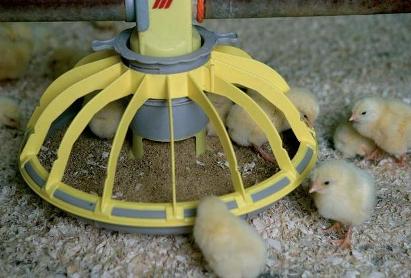Meeting the demands of the energy climate era

Although the poultry sector is heavily criticized by NGOs with respect to animal welfare and its environmental impact, everyone in the poultry industry strongly believes in a bright future. Both of theses public issues cannot be ignored and should stimulate poultry producers, as well as all players in the industry, to make the sector a highly appreciated and sustainable agro-business. Could the energy climate era provide an answer?
By Wiebe van der Sluis
| Post-hatch feeding has positive effects on chick development. The effect, however, is greatly influenced by the type of feed. |
Energy is a key word when it comes to predicting the future. Everybody is talking about the limiting availability of oil, gas and coal, and the possibilities of wind and solar energy. But what about the digestible energy living creatures like humans and animals depend on? These energy resources show limitations too.
Despite the economic crisis, the world’s population will continue to grow and the increasing number of people will have to be nourished. These people prefer a variety in foodstuffs of plant and animal origin. It has often been discussed that to some level animals and people may compete for the same plant-related products. It may become more and more difficult to defend the use of grains for animal nutrition where in some parts of the world humans suffer from famine.
UN Statistics predict that by 2030 the developing world could see an additional50 million tonnes of feed consumed, but it is questioned where this will be produced. The answer has to come from the agricultural society. It should take on the challenge to expand the production of food and feed grains in order to feed the world. The industry will meanwhile have to look for technologies that allow the efficient use of (alternative) feed ingredients, so less feedstuffs are transported over a long distance. By doing so, it will take its share in reducing global warming and saving energy.
One of the companies that are taking this issue seriously is Alltech. It has introduced a number of programmes and solutions that support healthy and efficient growth of animals, but comply with the demands for a sustainable animal feed and food industry.
Ammonia reduction
Protecting the environment is not a new issue for the poultry industry. Many studies have aimed at helping poultry producers to reduce the production of toxic or obnoxious gasses, as well as how to reduce environment-harming by-products. In both areas the industry has been rather successful. Scientific reports show that among a range of agro-industries, poultry performs the best where it concerns its contribution to the reduction in global warming.
Ammonia (NH3) is known to play a role in global warming. It is an anaerobic breakdown product of manure causing a bad smell. The gas is also associated with adverse effects on birds. In the early 1990s, numerous trials indicated feeding extracts of the Yucca schidigera reduced ammonia levels in high-rise layer houses as well as before and after composting manure, no matter the time of year. Dry matter and crude protein content of manure from birds given the extract was significantly lower (Table 1).
Besides environmental effects, the extract also showed improvements in egg output, bird health, mortality, and feed conversion. This is especially the case in poultry kept under confined conditions, but Wilson Sy Y Angeles of the College of Veterinary Medicine, Gregorio Araneta University in Manila, Philippines, showed that the ammonia reduction in open-air ventilated housesalso significantly improved the European Efficiency Factor of broiler flocks.
Reducing mineral pollution
Protecting the environment starts withthe sensible use of our natural resources.Here, too, the livestock industry, particularly the poultry industry, has done a lot to improve the efficient use of feed ingredients. Enzymes have contributed to better digestion and absorption of important nutritional compounds, andhave reduced the presence of unfavourablemicroorganisms in excreta, and improvednitrogen and phosphorus utilisation. Consequently, less nitrogen compounds(0.06-0.07%), undigested protein (0.18-0.50%)and phosphorus (0.05-0.08%) was excretedin the manure, and the productivity of broilers, turkeys and layers improved (Table 2).
The use of inorganic minerals as a total replacement of inorganic sources for feed is another tool to improve the efficient utilisation of scarcely available trace minerals. Researchers at the Agricultural University of Warsaw in Poland concluded that full replacement of inorganic minerals with an organic form is possible, effective and safe foranimals as well as the environment. Theyproved that organic minerals are better absorbed than inorganic forms, which allowed them to state that inorganic trace minerals can be included at a much lower level and still be effective in broilers as well as layers (Table 3).
Search for alternative resources
Traditional nutritionists used to create feed based on soy and corn. These compounds are grown in effluent in a limited number of countries. The unequal distribution makes many countries dependant from imports and thus from the currency exchange market. Under the current financial crisis, this dependency is not helping to predict future development options. Therefore, the use of more domestically grown crops should be considered. Thanks to the capabilities of new processing technologies and the addition of enzymes and other additives, these locally available ingredients can be considered as a viable alternative to corn and soybeans.
Meanwhile, more attention should be given to safeguard t
| The Sustainability Principle Alltech is one of the many global poultry health and nutrition companies that takes public concerns seriously. Throughout the years these issues have formed part of their annual nutrition symposium. This year, Alltech’s 25th Annual Symposium focused on finding answers to some of the major issues facing the animal feed industry, such as rising feed costs, managing in a time of crisis, and sustaining and growing business in the current environment. The theme of the event, which took place in Lexington, Kentucky, US, was “The Sustainability Principle – securing long-term profitability in a period of crisis”. During the meeting, Dr David Byrne, former EU Commissioner for Health and Consumer Protection, was awarded with Alltech’s Medal of Excellence. He took part in the Plenary Session where he discussed crisis management in today’s environment. |
he quality of feed, no matter their origin. Poor harvest and storage conditions often have a detrimental effect on the safety of feed and therefore the health and performance of livestock and poultry. Particularly the development of multiple mycotoxins is responsible for major losses. Many field and lab trials have shown the advantage of including mycotoxin adsorbents in feed. This is particularly the case in tropical countries where harvest and storage conditions are sub-optimal.
Indian researchers demonstrated that egg production in layers exposed to severe mycotoxicosis could be restored supplementing the toxin-binding glucomanna polymer (Mycosorb). It is often believed that laying hens can deal with relatively poor quality feed raw materials, which by itself is incorrect even when ignoring the fact that the feed is too often contaminated with high levels of mycotoxins. Although this feed could be relatively cheap, it often proves to be fairly expensive due to losses caused by suppressed feed intake, growth, feathering, egg production and feed conversion. The researchers therefore concluded that the return on investment should be the criterion when choosing a mycotoxin binder rather than the cost of inclusion alone.
Understanding the bird’s needs
Saving on scarcely available natural resources in a market where there is an increase in demand for food and feed is not possible by only reducing the losses due to poor harvest and storage practices. Neither can it be done alone through the use of additives that improve the digestibility of the feed ingredients. The poultry industry will have to make a few more steps forward in order to meet the futu re demands for sustainability. Besides opening up the secrets of feed digestibility and optimising the utilisation of the available ingredients, the industry will have to learn more about the demand and effect of nutrients in every single phase of the chicken’s life.
Over the years poultry researchers have done a lot of good work to better understand how birds convert feed into meat and eggs. More recently the attention moved to neo-natal chick nutrition, which ultimately may lead to an incredible improvement in flock performance. Research by Uni and Ferket (2008) and supported by Alltech suggests that even in ovo feeding can serve as an additional tool to support chick development before and after hatch. While in ovo feeding is still very much in its infancy, the main focus in commercial production will remain on post-hatch feeding.
Post-hatch feeding positively affects chick development, but the effect is very much influenced by the type of feed. Alltech discovered that the presence of nucleotides in the chicken’s ration is very important. These semi-essential nutrients play a major role in gut development and repair, skeletal muscle development, heart function and immune response. This will lead to healthier chicks, and birds that are able to convert feed in a more efficient way, requiring less feed to grow to market weight. Field research and experiments with a yeast extract rich in nucleotides, also offering components such as inositol, glutamate, peptides, minerals and vitamins, have confirmed this assumption (Table 4).
These examples show that the poultry industry is working hard to further improve its efficiency so less feed and energy resources will be needed to meet the increasing consumer demand for healthy, safe and sustainably-produced proteins of animal origin.
Join 31,000+ subscribers
Subscribe to our newsletter to stay updated about all the need-to-know content in the poultry sector, three times a week. Beheer
Beheer








 WP Admin
WP Admin  Bewerk bericht
Bewerk bericht